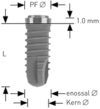Dental implant site preparation with conventional rotary drill or piezosurgery: five-year after placement results from a within person randomised controlled trial
- PMID: 39692785
- PMCID: PMC11655934
- DOI: 10.1186/s40729-024-00582-7
Dental implant site preparation with conventional rotary drill or piezosurgery: five-year after placement results from a within person randomised controlled trial
Abstract
Purpose: To evaluate whether there are clinical benefits by preparing dental implant sites using piezosurgery instead of conventional rotary drills in healed bone crests and if initial crestal soft tissue thickness could have an impact on marginal bone loss.
Methods: Twenty-five partially edentulous patients requiring two single implants in molar/premolar areas had each site randomly allocated to either piezosurgery or to conventional rotary drill preparation according to a split-mouth design. Definitive screw-retained metal-ceramic crowns were delivered after 6 months. All patients were followed to 5 years after placement. Outcome measures were: implant/crown failures, complications, peri-implant marginal bone level changes, resonance frequency analysis (RFA), and time required to complete site preparation, recorded, when possible, by blinded assessors.
Results: No patients dropped-out and no implant failed. Five years after placement, there were no statistically significant differences for complications (only one complication in the piezo group: difference = 0.04; P = 1), for peri-implant bone loss (difference = -0.11 mm; 95% CI -0.24 to 0.01; P = 0.083), and for RFA changes (6 months) (difference = -0.35; 95% CI -1.95 to 1.25; P = 0.672 between groups). Significantly more time was needed to prepare implant sites with piezosurgery (difference = 236.8 s; 95% CI -286.12 to -187.48; P < 0.0001). Initial soft tissue thickness had no effect on peri-implant bone loss (estimate = 0.05; 95% CI -0.03; 0.12; P = 0.239).
Conclusions: No clinically appreciable differences were noticed when placing implants using piezosurgery or conventional instrumentation with rotary drill, however, the preparation with rotary drills was on average 4 min faster. No effect of initial crestal soft tissue thickness was observed on peri-implant bone loss.
Keywords: Dental implants; Implant site preparation; Piezoelectric surgery; Rotary drills.
© 2024. The Author(s).
Conflict of interest statement
Declarations. Ethics approval and consent to participate: The study protocol was approved by the University of Mainz Ethics Committee (Ethics Committee No.: 837.1 85.1 5 (9953)). All patients signed a specifically informed consent that was approved by the ethical committee in order to participate in the present trial. Consent for publication: Not applicable. Competing interests: The authors declare no competing interests.
Figures








Similar articles
-
Conventional drills vs piezoelectric surgery preparation for placement of four immediately loaded zygomatic oncology implants in edentulous maxillae: results from 1-year split-mouth randomised controlled trial.Eur J Oral Implantol. 2017;10(2):147-158. Eur J Oral Implantol. 2017. PMID: 28555205 Clinical Trial.
-
Implant site preparation using a single bur versus multiple drilling steps: 4-month post-loading results of a multicenter randomised controlled trial.Eur J Oral Implantol. 2015 Autumn;8(3):283-90. Eur J Oral Implantol. 2015. PMID: 26355172 Clinical Trial.
-
Short implants versus longer implants in vertically augmented posterior mandibles: a randomised controlled trial with 5-year after loading follow-up.Eur J Oral Implantol. 2014 Winter;7(4):359-69. Eur J Oral Implantol. 2014. PMID: 25422824 Clinical Trial.
-
Subcrestal placement of dental implants with an internal conical connection of 0.5 mm versus 1.5 mm: Outcome of a multicentre randomised controlled trial 1 year after loading.Eur J Oral Implantol. 2017;10(1):73-82. Eur J Oral Implantol. 2017. PMID: 28327696 Clinical Trial.
-
Comparison of conventional twist drill protocol and piezosurgery for implant insertion: an ex vivo study on different bone types.Clin Oral Implants Res. 2017 Feb;28(2):207-213. doi: 10.1111/clr.12783. Epub 2016 Jan 22. Clin Oral Implants Res. 2017. PMID: 26799448
References
-
- Stacchi C, Vercellotti T, Torelli L, Furlan F, Di Lenarda R. Changes in implant stability using different site preparation techniques: twist drills versus piezosurgery a single-blinded, randomized, controlled clinical trial. Clinical Implant Dentistry Related Res. 2013;15:188–97. - PubMed
-
- Canullo L, Penarrocha D, Penarrocha M, Rocio AG, Penarrocha-Diago M. Piezoelectric vs. conventional drilling in implant site preparation: pilot controlled randomized clinical trial with crossover design. Clinical Oral Implants Res. 2014;25:1336–43. - PubMed
-
- Vercellotti T, Nevins ML, Kim DM, Nevins M, Wada K, Schenk RK, et al. Osseous response following resective therapy with piezosurgery. Int J Periodontics Restorative Dent. 2005;25:543–9. - PubMed
-
- Bengazi F, Lang NP, Canciani E, Vigano P, Velez JU, Botticelli D. Osseointegration of implants with dendrimers surface characteristics installed conventionally or with Piezosurgery(R) a comparative study in the dog. Clinal Oral Implants Res. 2014;25:10–5. - PubMed
-
- Sagheb K, Kumar VV, Azaripour A, Walter C, Al-Nawas B, Kammerer PW. Comparison of conventional twist drill protocol and piezosurgery for implant insertion: an ex vivo study on different bone types. Clin Oral Implant Res. 2017;28:207–13. - PubMed
Publication types
MeSH terms
LinkOut - more resources
Full Text Sources

